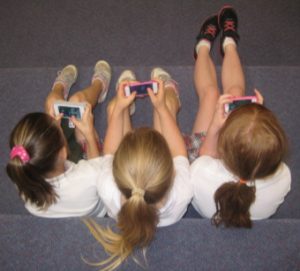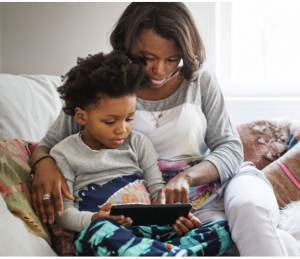Mal Lee and Roger Broadie
The digitally connected young of the world in naturally growing their being digital (Lee and Broadie, 2018 a) have increasingly taken charge of their learning with the technology, and developed – invariably unwittingly – the vital art of knowing how to learn autonomously.
It is a core educational capability they will use, and naturally evolve everyday lifelong – albeit outside the school walls.
It is a new, historic normal that governments and most schools are seemingly unwilling to recognise or build upon, most preferring to perpetuate the myth that learning in a networked world must continue to occur only within school walls, taught and assessed in a structured manner, by professional teachers.
In recent years, even the very young – before they can read and write – have instinctively taken advantage of the freedom given them by their digitally connected families to naturally grow their ability as autonomous learners.
It is a natural development, and a vital educational capability that parents, governments and educators should be more consciously recognising and developing.
In providing the young the agency and the technology, and freedom to directly access to the learning of the networked world, free of the traditional gatekeepers, the families have enabled their children to grow being digital (Negroponte, 1995), (Lee and Broadie, 2018 a), and in their everyday use of the technology to take charge of much of their learning, and to naturally evolve their ability to learn autonomously.
It is a historic step few schools are willing to take.
It gives the young a powerful base upon which to grow their learning, to use the tools in their hands creatively and to use the myriad of evolving digital resources available. They can author their own e-books, create their own blogs or videos, instantly use the likes of Google, YouTube, Wikipedia or the array of streaming services, and draw upon their friends, networks, learning packages, interest groups and specialist sites when desired – without ever having to involve a school teacher. That said, they can readily collaborate in their school studies, if the school desires.
Perhaps most importantly the development has enabled near on two billion digitally connected young (UNICEF, 2017) to naturally, instinctively and largely invisibly grow their ability to learn what they want lifelong, by simply using the evolving technology provided by their families. Daily they grow their capability by doing, by discovering, by turning to friends, peers and the resources online, and searching out the assistance they require, the moment desired.
Twining (2018) uses the expression ‘human learning’ to describe the approach. It has none of the fanfare, structure or cost of traditional school learning but has been immensely efficient and effective in readying near 70% of the world’s young to know how to learn, and thrive within, and accommodate a world of accelerating societal change.
While schools have struggled to remain current in the digital world the young outside the school daily operate at or near the cutting edge with the technology, giving scant thought to ease with which they evolve in harmony with the accelerating change.
It gives all the young, but particularly the marginalised of the world, the opportunity to naturally shed intergenerational disadvantage and to take charge of their learning and lives (UNICEF, 2017).
That said the corollary is that those without the digital connectivity will be further disadvantaged.
For aeons governments and educators have proclaimed the importance of individualising learning, and teaching the students how to learn. Those aspirations appear in most nation’s guiding educational principles. They are seldom effectively addressed. Aged organisational structures, tightly prescribed common curriculum, the pre-occupation with specified outcomes and standards, the focus on class groups, norm-referenced assessment, common skills tests, and external national exams all work to ensure the learning is not individualised, and the students are not readied as autonomous learners. They are simply taught how to learn in a supervised environment.
Outside the school walls, in taking advantage of families laissez faire approach to learning (Lee and Broadie, 2018 b), the young have over the last twenty plus years individualised their learning with the digital to a degree never seen in schools, and globally would appear to have taken major strides in learning how to learn lifelong with the evolving technology.
Nature of the learning.
On reflection, there has been a suite of related developments that have combined to bring about this historic change.
From the mid 90’s the young globally instinctively opted to take charge of their out of school use of and learning with the digital and the online. They were happy to use the support provided online, and that of their peers, but saw little need to call upon their school teachers (Purcell, et.al, 2013).
From the outset, the young adopted a laissez faire approach to learning with the digital, an approach based on trust, empowerment and agency, antithetical to the structured ‘control over’ model used by schools worldwide. The approach gave the young the freedom to learn what they wanted, how, when and where they desired, using the tools they thought best for the situation. Control was very much with the learner. It was a highly flexible approach, that allowed the child to collaborate with peers, to socially network, to play with the new, to try things, discover, innovate, take risks and learn from experiences. Importantly it obliged the learner to make judgements and to call the play.
By the latter 90’s the Tapscott study (1998) was able to identify the traits and mores the young had universally adopted in using the online and the digital. It also noted that for the first time in human history the young often knew more about a key area of learning than their elders.
Tellingly those traits had naturally grown in the young’s every day, fully integrated use of the evolving technologies.
One of the traits to emerge early was the adoption of a digital mindset, where the digital underpinned near all human activities, becoming increasingly powerful, sophisticated and all – pervasive.
In marked contrast to the school focus, the young, and increasingly their parents, were focussed on learning what would assist them in their everyday lives, today. They decided what they wanted to learn, not the ‘experts’.
The young’s out of school learning has been – and continues to be – characterised by its on-going, highly dynamic nature. There is an unwritten recognition of needing to remain up to date, able to use the desired current technology the moment desired, lifelong. They appreciated the imperative socially, educationally and likely economically of working at or near the cutting edge.
The learning is moreover strongly individualised from very early in life, the digital empowered young using the technology to pursue their own interests and passions. While ready to seek support from the technology, that online, the family, friends and from around the age of six to network with others (Chaudron, et.al, 2018) the children take charge of their own learning with the digital.
In pursuing their own interests and passions they soon tailor their suite of digital tools and capabilities, tools and capabilities that will evolve and change as the technology becomes more sophisticated and they mature and vary their interests. This is evident from the age of three onwards (Chaudron, 2015, Lee and Broadie, 2018 b) with siblings invariably quickly – and rightly – developing different digital skillsets.
We say ‘rightly’ very deliberately, because children in different global settings, with different interests and needs should grow the apt capabilities, and do as we all naturally now do and develop those used most. In a world of diverse interests, and uses of the digital technology it is naïve to assume – as most school authorities now do – that all the nation’s young should learn a common, ‘one size fits all’ set of practises.
The moment a game changing technological development occurs the young will rightly use the facility, happy to discard or trash the superseded technology.
In individualising and continually updating their suite of digital tools and capabilities the young are naturally- but likely unwittingly – evaluating their needs, and growing the ability to take charge of their learning in a continually evolving, often uncertain digital world.
History reveals the young have continually been to the fore in the adoption of the new technologies and practises (Lee and Winzenried, 2009), handling with ease the accelerating evolution, with no hint that is about to change.
That capability has been enhanced at all age levels by having immediate connectivity, the young being able to use the digital and the networked world the moment they believe it is important. It might only be photographing a noteworthy moment, contacting peers for assistance or checking information but is that sense of control that is important. It allows them to learn just in time and in context.
Something that would not be allowed in most schools.
Application of the self- directed learning
The digitally empowered young demonstrate their ability to take charge of their own use of and learning with the digital, and particularly touchscreen, technology from
very early in life, naturally growing their ability to use the evolving media for the desired purposes (Chaudron, et.al, 2018).
Critically the signs indicate they will naturally evolve that capability lifelong, with family and peer support, regardless of what the schools do, developing their capacity to use the myriad of apps and online resources the moment desired. The Apple and Google app stores alone each have over two million different apps.
Significantly the young, seemingly worldwide, have grown – and are daily growing their understanding how to learn, particularly with the digital with no assistance from most educators or schools.
Enhancement and collaboration
We are not for a moment suggesting that capability can’t be enhanced. It most assuredly should be. Few of the young will for example be developing the many skills associated with scientific, or the broader academic learning.
They will need to be grown.
But grown in a manner that builds upon the attributes already acquired, attributes the young will continue to evolve lifelong regardless.
Those attributes must be valued, not as now devalued and dismissed as trivial.
Ideally the work of the young and their families should be complemented by the schools.
But at this stage history strongly suggests most schools and governments will continue to refuse to collaborate, dismissing the efforts of the families, and asserting that only they can, and should teach the young how to learn (Lee and Broadie, 2018b).
Conclusion
The young’s naturally learning how to learn is shaping as another historic change in youth education, and another instance of where the invariably tightly controlled, and inflexible traditional school approach to learning will remain at odds with the learning and education of the young of the world outside the school walls.
Once again it seems likely it will be left to digitally connected families or the exceptional visionary schools to markedly enhance this critical educational skill.
- Chaudron, S (2015) Young Children (0-8) and Digital TechnologyLuxembourg, European Commission JRC and Policy Reports 2015 –http://publications.jrc.ec.europa.eu/repository/handle/JRC93239
- Chaudron S, Di Gioia R, Gemo M, (2018) Young children (0-8) and digital technology, a qualitative study across Europe; EUR 29070; doi:10.2760/294383 -
- Lee, M and Broadie, R (2018 a) ‘Being Digital’ Linkedin – https://www.linkedin.com/pulse/being-digital-mal-lee/?published=t
- Lee, M and Broadie, R (2018) Digitally Connected Families. And the Digital Education of the World’s Young, 1993 – 2016, Armidale, Australia, Douglas and Brown – http://douglasandbrown.com/publications/–
- Purcell. K, Heaps, A, Buchanan, J and Friedrich, l (2013) ‘How Teachers are Using Technology at Home and in Their Classroom’. Pew Internet– http://pewinternet.org/Reports/2013/Teachers-and-technology
- Tapscott, D (1998), Growing up digital: The rise of the Net Generation, McGraw Hill, New York
- Twining, P (2018) ‘What do you mean by learning?’ The halfbaked.education blog, 11thSeptember 2018. https://halfbaked.education/?p=63(accessed 26-Sept-2018)
- UNICEF (2017)Children in a Digital World. The State of the World’s Children 2017. UNICEF December 2017 – https://www.unicef.org/publications/files/SOWC_2017_ENG_WEB.pdf








